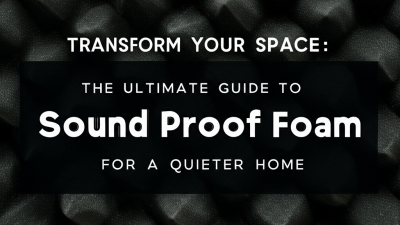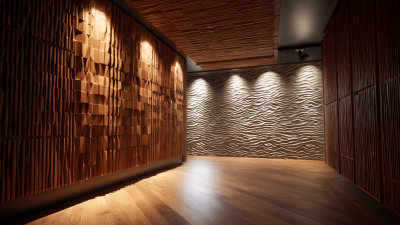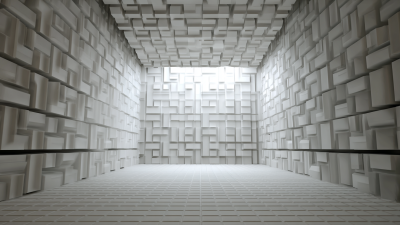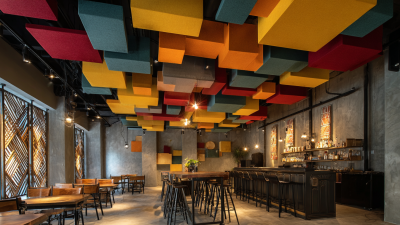In an increasingly noisy world, finding tranquility at home is more important than ever. According to a recent report by the World Health Organization, exposure to excessive noise can lead to various health issues, including stress and sleep disturbances. One effective solution that homeowners are turning to is sound proof foam, which not only enhances acoustic comfort but also improves overall living conditions. With the right materials, sound proof foam can reduce noise levels by up to 80%, making it a prime consideration for those looking to create a peaceful environment. This comprehensive guide will explore the best sound proof foam options available, offering insights into their applications, benefits, and installation techniques, ensuring that your home becomes a serene oasis amidst the clamor of everyday life.

Soundproof foam is not just a trendy home improvement but a scientifically-backed solution to noise pollution. Its effectiveness lies in how it absorbs sound waves and minimizes unwanted noise. This type of foam is designed with specific densities and textures that help reduce echo and reverberation within a space. By understanding the science of soundproofing, homeowners can make informed decisions on where and how to apply foam for maximum impact.
Tips: When selecting soundproof foam, consider factors like the size of the area you want to treat and the types of noise you wish to diminish. For optimal results, place foam panels in high-noise areas and at first reflection points on walls. Additionally, remember to combine acoustic foam with other materials, such as carpets or curtains, to enhance sound absorption further.
Incorporating soundproof foam can drastically change the ambiance of your home. For a more aesthetic approach, explore various colors and designs available in the market. Strategically positioning these foams on walls or ceilings can not only combat noise but also add a unique touch to your interior decor.
Soundproof foam is an invaluable addition to any home, providing numerous benefits that enhance your living environment. Firstly, it significantly reduces noise pollution. Whether you live in a bustling city or a noisy neighborhood, soundproof foam can absorb unwanted sound waves, creating a peaceful oasis within your own walls. This tranquility is especially beneficial for people who work from home or have children needing quiet space for study or rest.
Additionally, soundproof foam improves privacy. In multi-family homes or apartments, lifestyle sounds can carry easily between units. By installing soundproof foam panels, you can minimize disturbances and maintain a level of confidentiality, making your home a more comfortable retreat. Furthermore, this type of foam can enhance the quality of sound within your space, making it ideal for home theaters, music studios, or gaming rooms where audio clarity is paramount. With these advantages in mind, integrating soundproof foam into your home design is a practical choice for fostering a quieter, more serene environment.
This chart illustrates the top five benefits of sound proof foam in creating a quieter home environment. The scores represent the effectiveness of sound proof foam in achieving each benefit, with noise reduction being the most significant advantage.
When considering soundproofing your home, selecting the right type of soundproof foam is crucial. There are five popular types that cater to different needs and preferences. First, we have wedge foam, known for its efficient sound absorption characteristics. Its triangular shape helps reduce echo and reverberation, making it ideal for recording studios or home theaters.
Another option is pyramid foam, which features a distinctive pyramid shape that increases surface area. This design enables it to effectively trap sound waves while also providing aesthetic appeal, making it a favorite for creative spaces. Additionally, acoustic panels, which can come in various designs and finishes, are perfect for both soundproofing and enhancing decor, allowing for a stylish approach to noise reduction.
Tips: When choosing soundproof foam, consider the density and thickness, as denser materials absorb sound better. It’s also beneficial to combine different types of foam for optimal results, addressing both high and low-frequency sounds in your space. Lastly, strategically placing foam in corners and on walls can significantly enhance sound isolation.
When it comes to soundproofing your home, understanding noise reduction metrics is crucial. The most commonly used standard in the industry is the Sound Transmission Class (STC), which measures how well a building partition attenuates airborne sound. According to the American National Standards Institute (ANSI), a minimum STC rating of 50 is recommended for residential walls to ensure adequate noise reduction. For comparison, an STC rating above 60 is considered excellent and is typically achieved through specialized materials and construction techniques.
Another important metric is the Noise Reduction Coefficient (NRC), which evaluates how much sound is absorbed by a particular material rather than transmitted. Materials with an NRC of 0.85 or higher are effective for absorbing sound and are ideal for spaces where noise control is essential, such as home theaters or recording studios. According to a report by the Acoustical Society of America, incorporating soundproof foam with an NRC rating of 1.0 can help achieve significant sound absorption, leading to a more peaceful environment at home. Understanding these metrics can guide homeowners in selecting the right materials to transform their space into a quieter sanctuary.
Soundproof foam has become an increasingly popular solution for homeowners seeking a quieter environment without significant renovations. As data suggests, the soundproofing materials market, particularly for applications like acoustic foam, is projected to grow substantially, with the data center insulation market reaching USD 1.61 billion by 2032. This upward trend highlights not only the growing demand for soundproofing solutions but also the potential financial advantages of investing in high-quality acoustic materials.
Investing in soundproof foam can yield significant returns, both in terms of enhanced comfort and potentially increased property value. Homeowners can expect reductions in noise pollution, which improves the quality of life and promotes a peaceful living environment. Furthermore, professionals in the construction and home improvement industries recognize the importance of effective insulation in home design, making soundproof foam a worthwhile consideration for those looking to enhance their spaces economically while ensuring effective sound management.






